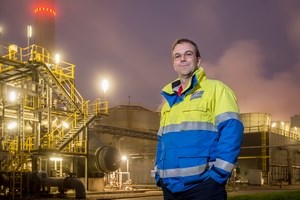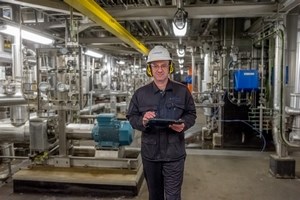Maurice Jilderda (right), in front of the dashboard, in this case of a centrifugal pump.
Article by Lucien Joppen
___
The face of Maurice Jilderda, development manager at Sitech Services (see box Sitech Services), visibly lights up when the future of maintenance is the topic of discussion. “At our Asset Health Center, we are busy shaping this future, working on more effective and efficient asset management procedures that at one point in the time will become mainstream.”
According to Jilderda, the seed for the Asset Health Center was planted in Sitech’s Vision 2020, which was devised by his colleague, Business Unit Manager Richard Schouten. “The idea behind the vision document”, Schouten explains, “was to formulate a shared vision on future maintenance, incorporating new, exciting technologies such as 3D-printing, dataanalytics and so on. Because Sitech is not involved in production but purely focused on manufacturing- and site services we are able to ‘disconnect’ from the day-to-day routine, take a step back and analyse new ways of conducting maintenance.”
Staying ahead
As explained by Schouten, Sitech specializes in asset management. Several companies on site have their operators on the pay roll but have chosen to outsource manufacturing and/or asset management in general to Sitech Services.
“Some choose to keep these services in-house, for example is the case with Sabic”, Jilderda says. “There is something to say for this approach. However, as Sitech has to be customer-focused, we strive to continuously improve our performance and subsequently our clients’ performance. We have to be ahead of the competition to prove our worth. Apparently we have succeeded as we are still in business after 10 years and also expanding our services to other chemical clusters in the Netherlands and abroad.”
Smart factory
Staying ahead of the competition implies more than doing your job, as Jilderda explains, it also implies experimenting and working with new concepts like the ’smart factory’ which ultimately lead to lower production costs (less unplanned down times etc.) and better and/or higher output. The Sitech Asset Health Centre (SAHC) plays a vital role in achieving these goals.
“We established the SAHC in 2016”, Schouten says. “In the years before, the Smart Industry Initiative, a publicprivate venture, was launched to promote the development of 4.0-concepts in manufacturing. We recognized that we could fit our SAHC-concept into this program and partly fund this centre.” According to Schouten, the SAHC has been set up to make predictive maintenance a reality and not some theoretical construct. “The term has been coined by the US Navy in the 1960’s but it has been a hollow concept for decades.”
Absence of data
The main reason for this, Jilderda says, is the absence of production-related and other data on various levels (assets, production lines, factory, sites). “Many companies do not have sufficient (historical) data in their databases and if they have sufficient data, they don’t know what to do with these data. It is understandable as most enterprises are geared towards manufacturing end products and the end often justifies the means. It is also a question of competences: an intricate knowledge of IT and analytics (machine learning, data modelling etc.) is required to analyse these data and use the outcome for predictive analytics. For example, at one point in time do you need to service a control valve?”
With the advances in computing and sensoring (equipment) the technological requirements are in place to facilitate ‘maintenance only when needed’. As it stands now however, the industry’s stance is hesitant to engage, because of the aforementioned ‘data gap’ and other perceived obstacles such as cost.
Future vision
The availability of data is not a problem of Sitech Services. In the ten years that the company is active, it has captured and stored production-related and other data from over 25 chemical plants that it services. Jilderda: “At the moment, we monitor roughly 600 assets, divided in various asset groups, such as valves, pumps, heat exchangers and so on. We monitor these equipment groups in various ways: through instrumentation that is already is place, such as temperature, pressure and flow meters, via additional sensors that measure aspects such as vibration (of the equipment), outside temperature, wind force and so on. We use these data for predictive models, viewed via our digital dashboards (see image) which gives us real-time insight of the monitored assets’ health status. By combining various data for particular assets we are also able to detect where things might go wrong in the foreseeable future.”
Less obvious parameters
When things go wrong they tend to lead to unplanned downtimes, for example because of a malfunctioning control valve. If from a group of ten control valves, one valve is experiencing problems, it is Sitech’s job to determine the cause(s) and to ensure it doesn’t happen again. Jilderda: “Via automated control valves we already capture necessary parameters to monitor the status. There are also less obvious parameters that might influence the performance of a control valve and equipment in general. Through experience we have been able to select relevant parameters for specific assets. These data are garnered by various types of sensoring devices.” Installing sensory devices is also driving up costs which might pose an obstacle for companies to invest in. Schouten and Jilderda both emphasize that sensoring should be affordable and easy to install in existing assets.
Saving potential
“Ideally, these devices should be taped to an asset and wireless”, Schouten says. “If the asset needs to be adjusted/ modified, most companies would be very hesitant. Cost is an issue. There are solutions on the market that are reliable but frankly are too expensive, bearing in mind that many sensors are needed on different places. Clearly there is a market gap for sensoring solutions that can be installed for less than EUR 1000, especially sensors that are ATEX-certified. We have developed our own solutions, sometimes based on toy-like devices that also do the job reliably. For example, we use a temperature sensor, based on a consumer product, which is currently employed at a factory on Chemelot. The cost for this device is only a couple of hundreds of Euro’s but it has a saving potential of thousands of Euro’s per year.”
Critical asset
These savings, which Schouten mentions, already have been realized in several of the pilot projects which have been conducted in Sitech’s Asset Health Centre. Jilderda mentions an example of a critical asset – a piston type rotary pump – that showed signs of critical wear during the testing phase. Based on the ‘warning signals’ via SAHC’s computer system, a specific part of the pump could be revised during a planned stop. “We managed to save approximately EUR 100.000 impact per year including production losses and costs. Based upon this case, we have devised a predictive model for this asset, as is the case for various other assets such as ventilators, heat exchangers, control valves, compressors and centrifuges.”
Complex ecosystems
As Jilderda explained earlier, the SAHC provides early warning signals. “Most of these alarms are not being sent to the operators because we don’t want to distract them from their job which is to keep the production lines running smoothly”, Jilderda says. “Furthermore, they would be overwhelmed by these signals. These are sent to asset engineers or technicians who are responsible for maintenance. We train our personnel in how to assess these signals and which corrective actions need to be taken. Sometimes only one parameter for a certain valve suffices to act upon, other issues are more complex and require deeper analysis. Factories are complex ecosystems with an enormous amount of variables; with our SAHC we are trying to unravel these ‘threads’ and optimize the plant’s performance.”
Sitech Services
Sitech Services has been established in 2008 at the Chemelot chemical site in Geleen in the south of the Netherlands, but has a long track record as it originated from the service departments of former DSM’s divisions. Chemelot is a unique chemical and materials community that ensures accelerated business growth through the open exchange of ideas. A growing environment for economy and working space, with the goal to become world class in 2025 in (more sustainable) chemistry and new materials. At the moment, Sitech Services employs approximately 900 experts for more than 25 production facilities on the Chemelot-site.
Energy saving
Reducing downtime while optimizing operations and /or maintenance is one of the objectives of the SAHC. As explained earlier in this article, the future plant’ is its credo. Other (potential) benefits of the SAHC for end users are energy saving, improve yield and the ability to predict product quality.
Schouten: “In the chemical industry, energy use is an important production cost factor. By closely monitoring production lines, we are able to detect deviations from the norm and to advise on adjusting certain production parameters. Needless to say, these adjustments should not be at the expense of volume and quality of the output. In fact, we are working in a pilot to predict and ultimately improve specific grades in higher volumes.”




